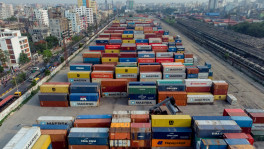Reform hopes rise as China focuses on inward economic shift
As tensions between Washington and Beijing rise, the potential decoupling of the world’s two largest economies presents significant risks, a prospect that is firming China’s resolve to shift reliance to its own vast domestic market

Chinese reform advocates are hoping President Xi Jinping's proposed new economic model, expected to be the centrepiece of a key conclave next month, is an opportunity to quicken changes to spur domestic demand and tackle structural woes.
The new development model will be discussed at a meeting of the ruling Communist Party in October, where policies are expected to be built into the next five-year road-map for the economy, policy insiders said.
Xi in May proposed a "dual circulation" strategy for the next phase of economic development in which China will rely mainly on "domestic circulation" - an internal cycle of production, distribution and consumption.
That will be supported by "international circulation", in which China further integrates with the global economy, opening its doors to more foreign goods, capital and investment.
As tensions between Washington and Beijing rise, the potential decoupling of the world's two largest economies presents significant risks, a prospect that is firming China's resolve to shift reliance to its own vast domestic market, policy insiders said.
The gathering of the Central Committee, the largest of the Communist Party's elite decision-making bodies, will focus on the 2021-2025 plan for the country's social and economic development. It will be the 14th such plan since China embarked on rapid industrialisation under its first five-year plan in 1953-1957.
"It (dual circulation) will be a pivot of the 14th five-year plan. There will definitely be difficulties to make it work," said a policy insider.
Guided by the new strategy, elements of the 2016-2020 plan, including supply-side reforms and policies to spur urbanisation and innovation, are expected to be taken to the next level, the details of which will be unveiled at the annual parliamentary session next year.
Few details have been published on the scheme itself, but economists and think tanks are proposing various reforms that they deem crucial to steering a more self-reliant economic course and building long-term growth drivers, they said.
China's State Council Information Office did not immediately respond to a faxed request for comment.
Government advisers have called for faster reform of China's land and residency systems - key obstacles to its goal of building a highly urbanised, consumer-driven economy - and tackling a yawning rich-poor gap that has weighed on spending.
Overhauling giant state companies would help tackle deep-rooted economic distortions and help level the playing field for struggling private firms, they argued.
"Domestic circulation won't take off if we cannot do a good job on reforms," said a government adviser who declined to be identified.
At a meeting with Chinese economists on Aug. 24, Xi pledged to take more measures to break down "deep-seated institutional barriers", and reaffirmed a longstanding pledge to let markets play a decisive role in resource allocation.
In April, China's cabinet issued guidelines on improving market-based allocation of "production factors", including land, labour, technology and capital, in a bid to deepen market-oriented reforms.
To be sure, rebalancing the economy to rely more on consumer spending and less on inefficient investment and volatile exports has been a key policy goal for the past decade.
But many Chinese advisers and economists are disappointed over the pace of reform in recent years, as a stability-obsessed government has plucked lower hanging fruit and delayed more painful reforms first unveiled at a key party meeting in 2013.
Increased control by the ruling Communist Party over all aspects of society has raised doubts about faster changes.
"If we want to rely on domestic circulation, we must push reforms to unleash growth potentials," said Jia Kang, head of China Academy of New Supply-side Economics, a think tank.
'MIDDLE-INCOME TRAP'
The stakes are high.
Three decades ago, China took advantage of its abundant cheap labor, importing parts and components before re-exporting finished products. In recent years, it has pivoted towards consumption-led growth.
Last year, total exports and imports accounted for 32% of gross domestic product (GDP), down from a peak of 64% in 2006. Consumption as a share of GDP climbed to 55.4% last year from 49.3% in 2010, but was still far lower than 70-80% in developed economies.
While rebalancing has gained some traction, economists said further transformation is needed to help China evade the so-called "middle-income trap", a situation where an economy stagnates at middle-income levels.
The main obstacles are growing competition from countries with advanced technologies, as well as economies with lower labour costs.
China's economy has to grow 5% annually in the next five years to help it become a high-income nation, policy insiders said.
But growth this year, pummeled by the coronavirus crisis, is likely to slow to its weakest pace since 1976 - the final year of Mao Zedong's Cultural Revolution.
"The next five years will be a crucial period for bypassing the 'middle income trap'," said Xu Hongcai, deputy director of economic policy commission at China Association of Policy Science.
"As a big country, it's not realistic to rely on external demand, and we should strengthen stability of domestic supply chains and push transformation to move up the value chain."


 Keep updated, follow The Business Standard's Google news channel
Keep updated, follow The Business Standard's Google news channel

















